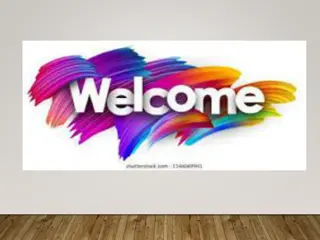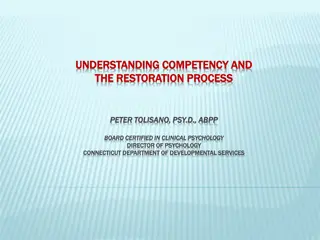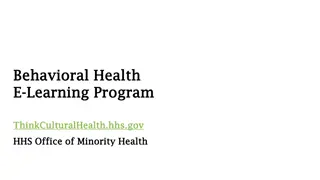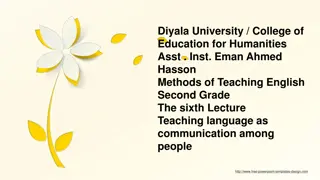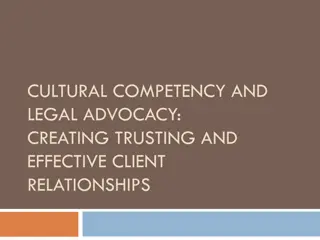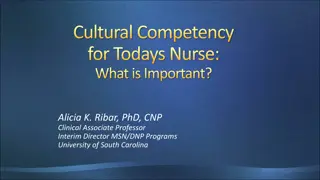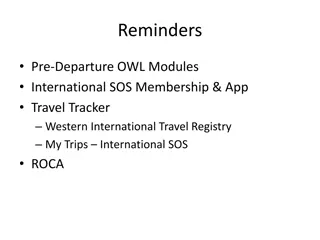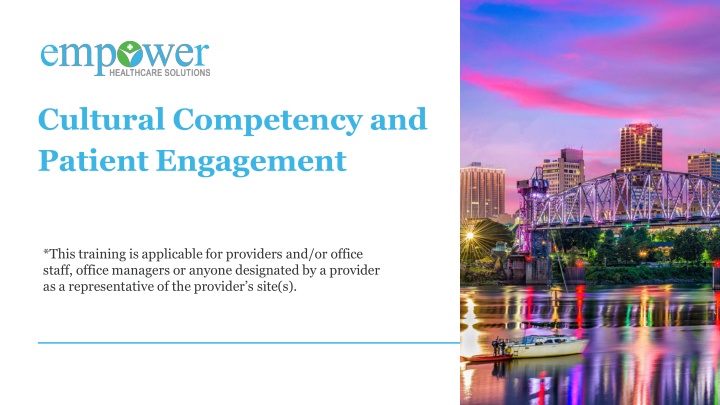
Cultural Competency in Healthcare
Explore the significance of cultural competency in healthcare, how it influences patient care, and why it's crucial for providers to enhance their understanding of diverse cultures. Discover the impact of culture on patient interactions, treatment outcomes, and the importance of adapting care to meet individual needs.
Download Presentation

Please find below an Image/Link to download the presentation.
The content on the website is provided AS IS for your information and personal use only. It may not be sold, licensed, or shared on other websites without obtaining consent from the author. If you encounter any issues during the download, it is possible that the publisher has removed the file from their server.
You are allowed to download the files provided on this website for personal or commercial use, subject to the condition that they are used lawfully. All files are the property of their respective owners.
The content on the website is provided AS IS for your information and personal use only. It may not be sold, licensed, or shared on other websites without obtaining consent from the author.
E N D
Presentation Transcript
Cultural Competency and Patient Engagement *This training is applicable for providers and/or office staff, office managers or anyone designated by a provider as a representative of the provider s site(s).
Why is cultural competency important? The Arkansas Department of Human Services (DHS) dictates Empower s obligation to provide cultural/language data. Empower is required to report the following to the state: 1. Annually on April 1, Empower must submit a Cultural Competency Plan (CCP) that addresses how providers, PASSE employees and systems will effectively provide services to people of all cultures, races, ethnic backgrounds and religions in a manner that recognizes, values, affirms and respects the worth of enrolled members and protects and preserves the dignity of each. 2. An annual evaluation of the effectiveness of the CCP must be submitted on April 1 addressing the demography of Empower s members, information demonstrating a direct link between the CCP and the annual evaluation, successes and challenges of meeting the previous years goals and objectives and the information in item 1 above. 3. A Provider Directory that, at a minimum, provides information on each participating provider s cultural and linguistic capabilities, including the languages offered by the provider or skilled medical interpreter at the provider s office and accommodations for individuals with physical disabilities, including offices, exam rooms, and equipment. Empower has the expectation that contracted providers will disclose their cultural, racial and linguistic information on an annual basis, particularly during contracting, credentialing and re-credentialing to ensure that services are provided in a culturally competent manner to all enrolled members. 2
What is culture? Culture refers to patterns of human behavior, including language, thoughts, communications, actions, customs, beliefs, values and institutions of racial, ethnic, religious or social groups. Culture creates standards for how we act and behave socially. 3
How does culture impact the care provided? Culture informs providers of: Patients concepts of health and healing Cultural factors influence: How patients define/evaluate situations How illness, disease and causes are perceived Help-seeking behaviors for problems Behaviors of patients who seek health care Patients presentation of problems, situations and information Patients response to interventions and service plans Patients attitudes toward health care providers Cultural awareness helps providers and staff modify behaviors to respond to the needs of patients, while maintaining a professional level of respect, objectivity and identity. 4
Why is increasing cultural competency important? Reasons to increase cultural competency Impact of increasing cultural competency Acknowledging patients varied behaviors, beliefs and values provides a positive impact on the quality of interactions with patients. Incorporating those variables into patients assessments, interactions and treatments increases patients trust and treatment adherence. Patients abilities to communicate symptoms improves as a provider s level of cultural competency and awareness increase. Belief systems related to health, healing and wellness are as diverse as the patients served. Help-seeking behaviors and attitudes toward providers and services are influenced by cultural and socioeconomic concerns. Individual preferences affect traditional and nontraditional approaches to health care. Health care providers from culturally and linguistically diverse groups are under-represented in the current delivery system Being available to patients and others as a cultural consideration As a provider, making personal racial and language information known during contracting and credentialing processes increases your availability to patients who use the online Provider Directory to locate providers with similar cultural and language backgrounds. 5
Empowers Commitment to Cultural Competency Empower is committed to having all network providers fully recognize and care for the culturally diverse needs of patients served. As a contracted health care provider with Empower Healthcare Solutions, our expectation is for all providers and provider staff to gain and continually increase knowledge and skills related to the sensitivities of diverse cultures. Consideration of a patient s values, realistic conditions and linguistic needs results in effective care and services. 6
Building Cultural Engagement with Patients is a Process. 1. Awareness of how culture shapes who you are as a provider. 2. Knowledge of how culture shapes the decisions each of us make as individuals. 3. Skills to build on cultural similarities and bridge cultural gaps. Culture is not only learned, it is shared, adaptive and constantly changing. 7
Individual Culture Each individual s culture: o Is a unique representation of the variation existing in larger culture. o Is learned as one matures. o Is shaped by the influences within one s social enviornment. o Changes over the lifetime of the individual. Each individual is a unique cultural package making cross-cultural encounters requiring strategies that open the door to discovering the individual s cultural preferences and frame of reference. 8
Why is Individual Culture Important? Because it impacts Our view of illness and what causes illness Our attitudes toward doctors, dentists and other health care providers An individual sculture is present in every health care encounter. Our help-seeking behaviors with our health care providers Our attitudes about seniors and individuals with disabilities Our beliefs about the role of caregivers 9
A Health Care Encounter Includes Multiple Components. Culture of biomedicine Because each individual patient brings his or her cultural background to a visit, there are many cultures at work in each health care visit. Provider s culture Culture of health care institution Interpreter s culture Patient s culture 10
Cultural Competency Continuum For each row, circle where you are now: Area of Competency Culturally Unaware Stage 1: Stage 2: Culturally Resistant Stage 3: Culturally Conscious Stage 4: Culturally Insightful Stage 5: Culturally Versatile Knowledge of patients Doesn t notice cultural differences in patients attitudes or needs Denigrates differences encountered in racial/ethnic patients Difficulty understanding the meanings of attitudes/beliefs of patients different from self Acknowledges strengths of other cultures and legitimacy of beliefs, whether medically correct or not Pursues understanding of patient cultures; learns from other cultures Attitude toward diversity Lacks interest in other cultures Holds as superior the values, beliefs and orientations of own cultural group Ethnocentric in acceptance of other cultures Enjoys learning about culturally different health care beliefs of patients Holds diversity in high esteem; perceives as valuable contributions to health care, medicine and patient well- being from many cultures Practice- related behaviors Speaks in a paternalistic manner to patient; doesn t elicit patient s perspectives Doesn t recognize own inability to relate to differences; tends to blame patient for communication or cultural barriers May overestimate own level of competent communication across linguistic or cultural boundaries Able to shift frame of reference to other culture; can uncover culturally based resistance, obstacles to education and treatment Flexibly adapts communication and interactions to different cultural situations; can negotiate culture-based conflicts in beliefs and perspectives Practice perspective Believes one approach fits all patients; no specialtreatment Has lower expectations for compliance of patients from other cultural groups Recognizes limitations in ability to serve cultures different from own; feels helpless to do much about it Incorporates cultural insights into practice where appropriate Incorporates cultural insights into practice where appropriate 11
Clear Communication: The Foundation of Culturally Competent Care
Did you know? The world's first hydrogen bomb was tested by the United States on the Marshall Islands on November 1, 1952? Springdale, Arkansas has the largest population concentration of Marshall Island natives outside their island home? As of March 2024, there are approximately 14, 000 Marshallese in Sprindale and their numbers continue to grow because of global warming and sea rise? The number one health problem for Marshallese in the United States is Diabetes? There are only two Marshallese doctors in the United States (as of March 2024)? 13
Barriers to Communication with Patients Communication Components: Linguistic Component Definitions: Speech patterns, accents or different languages may be used. Many people are getting health care coverage for the first time. Each person brings his or her own cultural background and frame of reference to the conversation. Health systems have specialized vocabulary and jargon. Limited experience (health care concepts and procedures) Cultural Systematic A patient s personal culture includes what he or she finds meaningful, including beliefs, values, perceptions, assumptions and explanatory frameworks about reality. 14
Benefits of Clear Communication Clear communication is a benefit to providers! Safety and adherence to treatment regiments Physician and patient satisfaction Office process Time and money Malpractice risks, medical costs Error that increases cost 15
Barriers to Patient Communication Patient Communication Barrier: Solution for the Communication Barrier: When I tell you I forgot my glasses, it is because I am ashamed to admit I don t read very well. I don t know what to ask, and I am hesitant to ask you. When I leave your office, I often don t know what I should do next. I m very good at concealing my limited reading skills. Use a variety of instruction methods. Encourage open-ended questions and use Ask Me 3*. Use the Teach Back* or Show Me* method. Use symbols and color on large print direction or instructional signs. Create a shame-free environment by offering assistance with materials. *See the Toolkit provided by Empower at the end of this slide deck. 16
Barriers to Patient Communication Patient Communication Barrier: Solution for the Communication Barrier: Explain how to use the medications that are being prescribed. Use specific, clear and plain language on prescriptions. Use plain language to describe risks and benefits and avoid using only numbers Explain the benefits of mental health services and/or personal care services. Explain assessment and care services in plain language, including limits on confidentiality or use of facilities that limit freedom s. I put medication into my ear instead of my mouth to treat an ear infection, because the instructions said for oral use only. I am confused about risk and information given in numbers, like percent or ratios, and don t know what I should do. I am afraid to talk about suicide, because I don t want to be locked up or committed. I am afraid to tell you that I need things, because I don t want to be taken from my home. 17
Barriers to Patient Communication Patient Communication Barrier: Solution for the Communication Barrier: Confirm decision-making preferences. Office staff should confirm preferences during scheduling. Spend a few minutes building rapport at each visit. Ask about the use of complementary medicines and home remedies. I am more comfortable waiting to make a health care decision after I talk to my family. Sometimes, I am more comfortable with a doctor of my same gender. It is important for me to have a relationship with my doctor. I use complementary and alternative medicines and home remedies, but I don t think to tell you. 18
Barriers to Patient Communication: Limited English Proficiency (LEP) Patient Communication Barrier: Solution for the Communication Barrier: My English is pretty good, but I need an interpreter at times. Some days it s harder for me to speak English. When I don t seem to understand, talking louder in English intimidates me. If I look surprised, confused or upset, I may have misinterpreted your nonverbal cues. Office staff should confirm language preferences during scheduling. Consider offering an interpreter for every visit. Match the volume and speed of the patient s speech. Mirror body language, position and eye contact. Ask the patient if they understand. 19
Language Assistance Services Language assistance is available at no cost to patients and providers, including: o Interpreter support at a medical point of contact. o Sign language interpreters. o Speech-to-text interpretation for hearing loss in patients who do not sign. o Patient materials in alternative formats (i.e., large print, audio and Braille). For more information, contact Member Services at (866) 261-1286 or TTY 711 Type Over the Phone Vendor(s) Primary Vendor Transperfect Connect Written Translation Services PurpleGroup MHP.SI (Marshallese) Communication Plus Interpreter Services American Sign Language-ASL Service Vendor 20
Effective Use of an Interpreter Speak directly to the patient, not the interpreter. Use the Teach Back method, even during an interpreted visit. Use first person language. Use a normal voice, not too fast or too loudly. Use concise, brief sentences that are uncomplicated. Avoid acronyms, medical jargon and technical terms. Interpreters are trained in medical terminology, but this will make interpretation smoother and clearer. It will extend confidence that the patient understood the message. Be aware of the cultural context of body language. Ensure that the patient understands that use of a family member as an interpreter is highly discouraged. 21
Using Professionally-Trained Interpreters Hold a brief introductory discussion with the interpreter. When patients are stressed by an illness, communication in their preferred language can improve understanding. o Introduce yourself and give a brief nature of the call/visit. o Reassure the patient about confidentiality practices. Be prepared to pace discussion with the patient to allow time for interpretation. Being prepared to use an interpreter, when needed, will keep the office flow moving smoothly. Avoid interrupting during interpretation. In some languages, it may take longer to explain a word or a concept, so be patient. Choose an interpreter who meets the needs of the patient, consider age, sex and background. 22
Alternate Format Requirements Under Title II of the Americans with Disabilities Act (ADA) and Section 504 of the Rehabilitation Act of 1973, federally conducted and assisted programs, along with programs of state and local government, are required to make those programs accessible to individuals with disabilities, as well as provide effective communication. Effective communication means to communicate with those with disabilities as effectively as communicating with others. Alternative communications supporting a patient encounter include sign language interpreters, tactile interpreters and captioning and assisted-listening devices. 23
Disability Sensitivity and Awareness
Americans with Disabilities Act (ADA) The ADA is divided into five titles, or sections, relating to different areas of public life: Section: Title I Topic/area addressed: Employment practices of private employers with 15 or more employees, state and local governments, employment agencies, labor unions, agents of the employer and joint management labor committees Programs and activities of state and local government entities Private entities that are considered places of public accommodation Telecommunications Title II Title III Title IV Title V Miscellaneous 25
How does the ADA relate to providers? Title II and Title III of the ADA and Section 504 require that medical care providers offer individuals with disabilities the following: Full and equal access to their health care services and facilities Reasonable modifications to policies, practices and procedures when necessary to make health care services fully available to individuals with disabilities, unless the modifications would fundamentally alter the essential nature of the services From the first contact a patient has with a provider s office, staff should be knowledgeable and not refuse services, provide separate or unequal access to health care services and avoid the appearance of discrimination against any person. Providing full and equal access to those with disabilities includes: Removing physical barriers. Providing a means for effective communication with those who have vision, hearing or speech disabilities. Making reasonable modifications to policies, practices and procedures. 26
Accommodations For Those with Disabilities Can Include Providing flexibility in scheduling Providing interpreters or translators for patients who are deaf or hard of hearing Having an understanding of disability-competent care Ensuring that patients and their companions are provided with reasonable accommodations that ensure effective communication, including auxiliary aids and services. Providing accessible facilities, including widened doorways and wheelchair ramps Providing reasonable modifications and accommodations Ensuring safe and appropriate access to buildings, services and equipment Allowing extra time for patients to: o Dress and undress. o Transfer to exam tables. o Speak with the practitioner to ensure full participation and understanding. 27
ADA, 504 and Linguistic Services Providers and office staff must be responsive to the linguistic, cultural and other unique needs of patients with disabilities and special populations, including the capacity to communicate with patients in languages other than English and with those who are deaf, hard of hearing or blind. Guidelines for Communicating with a patient with a disability Providers cannot rely on a minor to facilitate communication. Providers cannot require patients to bring another person to interpret. An accompanying adult can be relied on to facilitate communication, if it is an emergency or the patient requests it and the accompanying adult agrees. This arrangement must also be appropriate for the circumstances (28 CFR, Section 36.303). 28
Empowers Commitment to Cultural Competency Empower Healthcare Solutions has adopted all 15 national Culturally and Linguistically Appropriate Services (CLAS) Standards in health care to ensure all members who enter the health care system receive equal, quality and effective treatment. o CLAS standards can be reviewed by visiting the following website: https://thinkculturalhealth.hhs.gov/clas/standards Empower actively recognizes and understands the roles that age, culture, ability, socioeconomic status and ethnicity play in the lives of our members to ensure equal and effective access to health care, support systems and community services. 29
Thank You Contact Us Empower Healthcare Solutions, LLC PO BOX 211446 Eagan, MN 55121 Member Services: 866-261-1286 I TTY 711 Provider Services: 855-429-1028 getempowerhealth.com empowerhealthcaresolutionsPR@getempowerhealth.com
SOURCES Culture and Cultural Competency, U.S. Department of Health and Human Services, Office of Minority Health, https://minorityhealth.hhs.gov/ Better communication, better care: Provider tools to care for diverse populations, Health Industry Collaboration Effort, Inc. (July 2010) https://www.iceforhealth.org A physician s practical guide to culturally competent care, U.S. Department of Health and Human Services, Office of Minority Health (45-145) https://cccm.thinkculturalhealth.hhs.gov Ask Me 3 materials for providers, National Patient Safety Foundation, http://www.ihi.org/resources/Pages/Tools/Ask-Me-3-Good-Questions-for-Your-Good-Health.aspx Americans with Disabilities Act https://www.ada.gov 31
SOURCES Marshallese in Arkansas: https://www.arkansasmarshallese.org Resources for Integrated Care https://www.resourcesforintegratedcare.com


